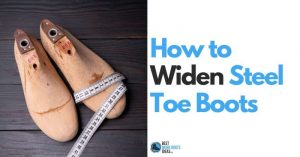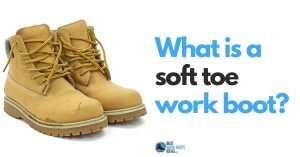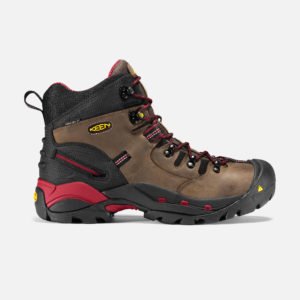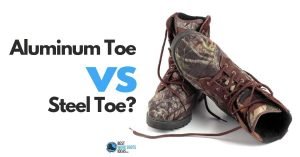How to Break In Steel Toe Boots: A Step-by-Step Guide
![how to break in steel toe boots [featured image]](https://www.bestworkbootsideas.com/wp-content/uploads/2023/07/how-to-break-in-steel-toe-boots-featured-image.jpg)
So, you’ve got yourself a brand new pair of steel toe boots.
They’re sturdy, they’re shiny and they’re ready to protect your feet from all manner of workplace hazards.
But there’s an issue. They’re stiff as a board.
You find yourself asking, “how do I break in these steel toe boots?”
Breaking in steel toe boots involves wearing them for short periods initially and gradually increasing the time. Use thick socks to cushion your feet and apply leather conditioner to soften the material. It’s also helpful to flex and bend the boots manually when you’re not wearing them.
Contents
Why Trust Me?
I’ve been in the work boot industry for over several years, writing about everything from safety features to comfort technology.
I’ve worn various pairs of steel toe boots and I’ve broken in each one using tried-and-true methods that ensure comfort without compromising safety.
My expertise isn’t just theoretical but it’s practical too.
Not only do I have a passion for this “stuff” but have extensively researched the intricacies of boot construction.
This I believe gives me an edge when it comes to offering suggestions on breaking into these tough cookies.
What Lies Ahead?
In this article, we’ll delve into:
- The challenges of breaking in steel toe boots
- The consequences of not properly breaking them in
- Detailed steps on how to effectively break in your new pair
- Nuances that could affect the break-in process
The Challenge: Stiffness & Discomfort
Steel toe boots are designed for protection first and foremost.
This means they often come with a level of stiffness that can be uncomfortable when you first wear them.
The protective cap around the toes doesn’t give easily which can cause discomfort or even blisters if you start wearing them for long hours straightaway.
The leather upper part may also feel tight around your foot causing pressure points while the sole might feel like walking on a plank due to its initial lack of flexibility.
Consequences: Pain & Potential Injury
Jumping right into full-time wear without properly breaking in your steel toe boots can lead to painful blisters or sores on your feet.
This discomfort can distract you from your work or even lead to more serious injuries if it affects your gait or balance.
Moreover, persisting through pain might cause you to unconsciously alter how you walk, leading to potentially damaging effects on ankles, knees or hips over time.
Solution: Gradual Wear & Care
Breaking in steel toe boots doesn’t have to be a painful process if done correctly:
- Start Slow: Begin by wearing your new boots around the house for short periods.
- Thick Socks: Wear thick socks or double up on regular ones for extra padding.
- Flex Them: When not wearing them, flex and bend the shoes manually.
- Condition Them: Apply leather conditioner regularly during this period.
- Gradually Increase Wear Time: As they start feeling comfortable increase wear time gradually until full day use is achieved without discomfort.
Remember patience is key here. Rushing this process will only lead back towards discomfort and potential injury.
Definitely not what you want.
Nuances: Material & Fit Matters
Different materials require different care during break-in period:
- Leather needs conditioning while synthetic materials might benefit from heat application (like using a hairdryer) but always check manufacturer guidelines before trying any method.
Fit also plays an important role here:
- Ensure there’s enough room around toes but not so much that foot slides inside causing friction leading blisters.
Understanding these nuances will help you tailor the break-in process according to your needs ensuring maximum comfort whilst maintaining safety.Learn more about how steel toe boots should fit.
The Issue: Heat and Moisture Build-Up
Another common issue when breaking in steel toe boots is the build-up of heat and moisture inside the boot.
This is often due to the fact that these boots are designed to be sturdy and protective. This can often mean they lack breathability.
Consequences: Uncomfortable Feet and Potential Health Issues
The buildup of heat and moisture can potentially lead to sweaty and uncomfortable feet.
Which means that over time, it may also lead to health issues such as athlete’s foot or other fungal infections.
Existing conditions like eczema or psoriasis may also be exacerbated.
Solution: Use Moisture-Wicking Socks and Foot Powder
So what can you do to try and combat the issue?
- Moisture-Wicking Socks: Invest in a few pairs of moisture-wicking socks. These are designed to pull sweat away from your skin, helping your feet stay dry.
- Foot Powder: Consider using a foot powder before putting on your socks. This can help absorb excess moisture.
- Let Them Air Out: When you’re not wearing your boots, let them air out properly. Don’t store them in a dark, damp place; instead, put them somewhere with good airflow.
Remember that everyone’s feet are different – some people naturally sweat more than others – so you may need to experiment with different solutions until you find what works best for you.
Nuances: Different Materials Require Different Care
Just as with breaking in the boot itself, different materials require different care when it comes to managing heat and moisture:
- Leather boots often need more time to air out than synthetic ones.
- Some materials may benefit from specific cleaning products or treatments designed to increase their breathability.
Always check the manufacturer’s instructions before trying any new treatment or product on your boots.
The Issue: Pressure/Pinch Points
Pressure points are another common issue when breaking in steel toe boots. These occur where parts of the boot rub against your foot or ankle causing discomfort or even pain over time.
Consequences: Blisters & Long-Term Discomfort
If left unaddressed pressure points can cause blisters making it nearly impossible to wear the boots without discomfort.
Ignoring these could lead to long-term discomfort even after the break-in period is over.
Solution: Identify & Address Pressure Points
Here’s how you tackle this issue:
- Identify Problem Areas: Wear your boots around the house identifying areas where they rub against your foot causing discomfort.
- Use Padding: Apply moleskin padding on the areas inside the boot. This will provide cushioning which will help to reduce friction.
- Stretch Them Out: If pressure point is caused by tightness consider using a shoe stretcher specifically targeting the problem area.
- Professional Help: In case pressure points persist consider taking them to a professional shoe repair shop for custom stretching.
Understanding where potential pressure points might form will help with a smoother break-in process overall.
Nuances: Individual Differences Matter
Every person’s foot shape is unique which means pressure points will vary from person person:
- Some might experience rubbing at the heel while others might feel it around toes or sides of their feet.
Once you are aware of where your issue lies, you can get to work and make your boot as comfortable for you as you can.
The Issue: Weight and Bulkiness
Steel toe boots by their very nature are heavier and bulkier than regular footwear.
This is due to the added protective features such as the steel cap and reinforced soles.
For someone not used to wearing such heavy-duty footwear, this can pose a challenge.
Consequences: Fatigue and Reduced Mobility
The extra weight of steel toe boots may cause fatigue, especially if you’re standing on your feet all day.
It might also take some time to get used to the bulkiness of the boots which may initially reduce your mobility or alter your gait (the way you walk).
Solution: Gradual Adjustment and Strength Training
Here’s how you can tackle this issue:
- Gradual Adjustment: Just like breaking in for comfort, getting used to the weight and bulk of steel toe boots should be a gradual process. Start by wearing them for short periods and gradually increase the time you wear them so you and your feet feel more comfortable.
- Strength Training: Probably something you may not have thought about. You might want to Incorporate lower body strength training exercises to condition your legs and feet. To handle the extra weight.
- Proper Lacing: Ensure that your boots are laced up properly. If they are too tight or too loose they will not provide adequate support.
Remember that while these boots may feel heavy at first, they are designed for safety and protection which outweighs any initial discomfort.
Nuances: Different Brands, Different Weights
Guess what? Not all steel toe boots are created equal:
- Some brands offer lightweight options that still meet safety standards.
- Others might use composite materials instead of steel for the toe cap which reduces weight without compromising on protection.
You should take these factories into account when purchasing work boots with a toe cap. Especially if you’re concerned about weight or bulkiness.
Ultimately, safety should also be paramount and the type of job you do should dictate your decision on whether a steel toe boot is actually required. However, that’s a different conversation for another time.
In Summary: Breaking In Steel Toe Boots – A Journey Worth Taking
Breaking in a pair of steel toe boots is indeed a journey; one that requires patience, care and understanding of both the footwear itself as well as one’s own unique needs.
From dealing with stiffness and discomfort to managing heat and moisture build-up; from identifying and addressing pressure points to adjusting to their inherent weight and bulkiness – each step brings us closer towards achieving that perfect fit where safety meets comfort seamlessly.
Don’t forget that every pair of new work boots are an investment in your foot health and workplace safety. It’s therefore always worth taking time to ensure they’re broken in correctly before stepping into the demanding environment you work in. With the right approach and techniques shared above, I’m confident you’ll soon be striding comfortably in those shiny new steel-toe protectors!
In essence:
- Start slow with short periods of wear
- Use thick socks for cushioning
- Regularly condition leather boots
- Manage heat & moisture with wicking socks and airing out
- Identify & address pressure points early
- Gradually get used to their weight
And always remember: different materials require different care methods; individual differences matter when it comes to potential pressure points; not all steel toe boots are created equal when it comes down to weight or bulkiness.
So go ahead! Take these steps towards breaking in your new steel toe boots. Your feet will thank you for it!





